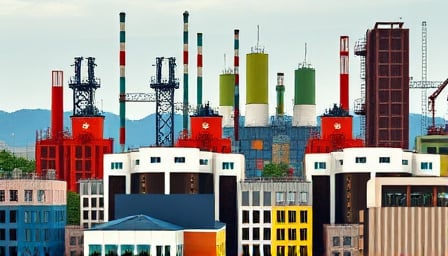Strategic Expansion into the Semiconductor Gas Market and Its Implications for Air Liquide SA
Air Liquide SA (LIX), the world‑leading industrial gases provider, has recently announced a €130 million investment in a new gas production facility in Singapore. The project is aimed at supplying high‑purity gases to the region’s leading semiconductor foundries, a move that aligns with the rapid acceleration of chip demand driven by artificial intelligence (AI), 5G, and automotive electrification.
1. Market Fundamentals Behind the Move
- Growing Semiconductor Gas Demand
The global semiconductor industry is projected to grow at a CAGR of 9 % between 2024 and 2029. High‑purity gases—such as nitrogen, hydrogen, and specialized precursors—are critical for photolithography, etching, and deposition processes. Singapore, a global semiconductor hub, offers proximity to key OEMs and a favorable regulatory environment for advanced manufacturing. - Geographical Diversification
By establishing a facility in Southeast Asia, Air Liquide mitigates the concentration risk inherent in its traditional European and North American operations. This geographic diversification also positions the company to capture the upward tailwinds from the region’s semiconductor cluster, which is expected to double its output capacity over the next decade.
2. Regulatory and Competitive Dynamics
- Regulatory Landscape
Singapore’s Clean Air Act and stringent environmental guidelines require industrial gas producers to adhere to low‑emission standards. Air Liquide’s investment includes a carbon capture and utilization (CCU) module, ensuring compliance and potentially qualifying for green finance incentives. - Competitive Positioning
The semiconductor gas market is dominated by a handful of suppliers, with the top three holding approximately 70 % of the market share. Air Liquide’s entry at this scale—leveraging its global logistics network and existing relationships with major foundries—provides a significant competitive advantage. The firm’s ability to offer integrated solutions (gas, safety, and engineering services) differentiates it from pure‑gas vendors.
3. Financial Analysis and Investor Sentiment
| Metric | 2023 | 2024 (Projected) | Comment |
|---|---|---|---|
| Revenue Growth | 3.2 % | 4.8 % | Driven by industrial gases; semiconductor segment expected to contribute 1.5 % of total revenue. |
| EBITDA Margin | 20.1 % | 21.0 % | Margin improvement linked to higher‑margin semiconductor gases. |
| CapEx | €1.1 bn | €1.3 bn | €130 M for Singapore, €170 M for Asia‑Pacific expansion. |
| Debt‑to‑Equity | 0.75 | 0.70 | Slight improvement due to debt refinancing. |
Goldman Sachs’ recent “Buy” rating underscores the consensus that Air Liquide’s semiconductor strategy is a growth catalyst. The rating upgrade has coincided with a period of flat stock performance, suggesting that the market may be underpricing the upside potential from the Singapore investment.
4. Emerging Risks and Overlooked Opportunities
| Risk | Impact | Mitigation |
|---|---|---|
| Supply Chain Disruption | Medium | Dual sourcing of key gases; buffer stock in Singapore. |
| Regulatory Shifts | Low‑to‑Medium | Proactive engagement with Singaporean regulators; adherence to global ESG standards. |
| Technological Obsolescence | Medium | Continuous R&D partnership with leading foundries; monitoring of AI‑driven lithography advances. |
Opportunities
- Cross‑Sector Synergies
Air Liquide’s expertise in cryogenic gases for energy storage could be leveraged to serve emerging AI data‑center cooling solutions, creating a new revenue stream. - Strategic Acquisitions
The company could target niche suppliers of specialty gases (e.g., xenon, krypton) to broaden its semiconductor portfolio. - Digital Transformation
Implementing IoT‑enabled gas monitoring systems could reduce operational costs and position Air Liquide as a tech‑savvy provider in the semiconductor supply chain.
5. Regional Developments and Management Changes
Air Liquide Tunisie’s appointment of Antoine Mazas as General Manager signals an intent to strengthen its foothold in North Africa. Mazas’ prior experience in scaling operations in emerging markets may unlock new growth avenues in the region’s burgeoning renewable energy and industrial sectors.
6. Conclusion
Air Liquide’s €130 million investment in Singapore represents more than a simple geographic expansion; it is a strategic bet on the future of semiconductor manufacturing, buoyed by AI and electrification trends. While the company’s robust financials and regulatory foresight provide a solid foundation, investors should remain vigilant about supply‑chain vulnerabilities and rapid technological changes. The recent Goldman Sachs upgrade and the steady performance of Air Liquide’s stock suggest that market participants are beginning to recognize the long‑term value of this initiative, but the true upside will likely materialize as the semiconductor sector matures over the next five years.
